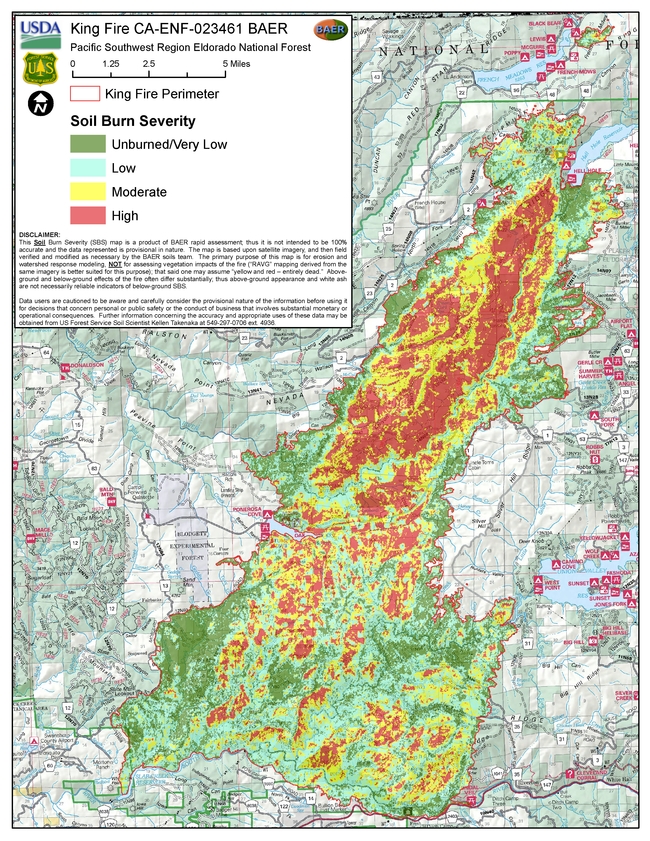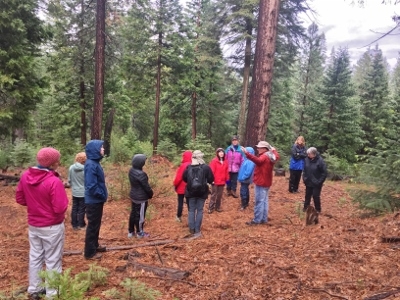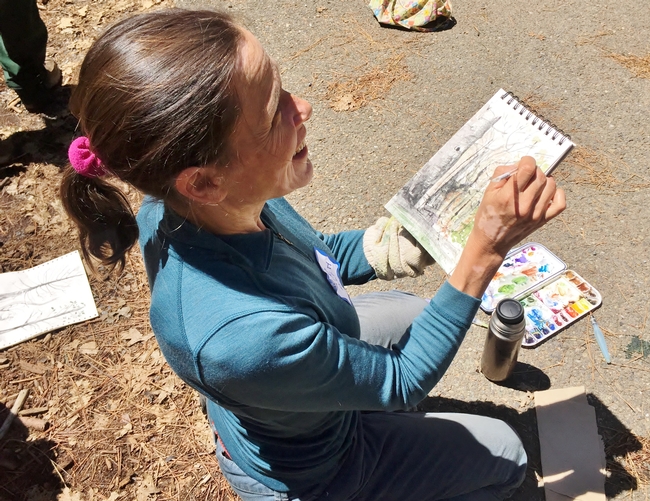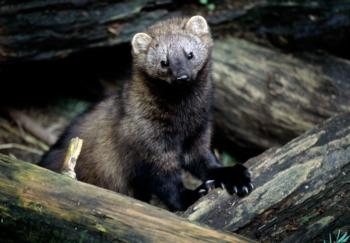Posts Tagged: SNAMP
King Fire provides learning opportunities
Over a dozen UC Agriculture and Natural Resources (UC ANR) California Naturalists, fire ecology experts, wildlife biologists, resource managers, educators, and artists met at UC Berkeley's Blodgett Forest Research Station and the adjacent El Dorado National Forest April 23 and 24, and not one of them complained about the much-needed deluge of rain and intermittent hail that soaked the group. The weekend's ambitious goal? To dive deeply into a UC California Naturalist Program and California Fire Science Consortium advanced training workshop on the subject of wildfire effects on Sierran mixed conifer forests.
With the 2014 El Dorado National Forest's King Fire as a case study, a mix of lectures, field studies, art, field journaling techniques, and Native American story telling were used to examine land management practices that influence fire behavior and explore how the landscape recovers from fire. UC ANR Cooperative Extension Central Sierra's forestry advisor Susie Kocher and community education specialist Kim Ingram organized and facilitated the workshop.
Blodgett Forest, situated on the Georgetown Divide in El Dorado County, was donated to the University of California in 1933 to provide a research site and practical demonstrations of forestry for students, forest industry, and the public. The adjacent El Dorado National Forest is home to the notorious September-October 2014 King Fire that burned 97,000 acres of forest, including 63,000 acres of public land. Aided by low relative humidity and wind, the fire spread quickly up the steep Rubicon River and surrounding subwatersheds. According to the incident report, approximately 46 percent of the burn area burned at a high and moderate soil burn severity, consuming all organic duff on the soil surface along with leaves and needles on standing live vegetation.
Workshop participants were treated to a lecture and field studies of basic fire ecology concepts by Scott Stephens, professor of fire science at UC Berkeley. Stephens lectured in class, and later demonstrated on a number of wet, lush forested treatment plots in the field, topics ranging from fire policy, fuels management options and objectives, and carbon sequestration to fire suppression consequences, fire behavior and severity, soil stability, and post-fire forest structure. Stephens is a researcher with the Sierra Nevada Adaptive Management Project (SNAMP), a long-term collaborative research project investigating how forest fuels thinning impacts fire behavior, fire risk, wildlife, forest health, and water. Fire is a vital to maintaining healthy California forests and ecosystems and Stephens's work demonstrates that both prescribed fire and its mechanical thinning replacements can successfully change forest structure and fuel loads, resulting in potential overall improvement of forest health. He finds that treated forest stands are more resistant and resilient to high-intensity wildfire and that these treatments have minor to negligible negative impacts on birds and small mammals, understory plant diversity, exotic plant invasions, and insect attack. Current and future research is in part focused on the impact and feasibility of treatments across the landscape.
Also joining participants was Sheila Whitmore from the University of Wisconsin-Madison. Whitmore is the assistant project leader on SNAMP's owl team, which studies how fuel reduction treatments affect California spotted owl survival, forest occupancy, and reproductive success. The California spotted owl is one of three sub-species of spotted owls and the only spotted owl that has not yet been placed on the endangered species list, although its population is widely thought to be declining. Late in the evening, accompanied by Whimore, three nocturnal field technicians, and armed with tools of the trade like bird call whistles and flashlights, participants quietly slogged deep into the forest along the 22-mile system of El Dorado Irrigation District canals, listening for the territorial four-note hoot of the California spotted owl. While the crew eventually found one female owl on the night hike, the owl team has just started surveying breeding territories this spring and are uncertain how and if the owls will be impacted by the King Fire. Modeling efforts and a radio telemetry study seek answers to questions about demography, habitat, individual range size, and foraging preferences, given different levels of severity in burned forests.
Day two of the workshop, under warm sunshine, began with a discussion of Native American fire ecology and traditional stories shared by Kimberly Shiningstar Petree. Petree is a Tumelay Nissenan Miwok, the cultural preservation officer for her tribe, and the founder of the Cosumnes Culture and Waterways, a non-profit dedicated to promoting, preserving, and stewarding Indigenous Culture and waterways of their land. As told by a descendant of the first stewards of the area's forests and a carrier of an ancient oral tradition, the fire stories that Petree shared with the group were both relevant to today's fire management practices, and moving, setting a positive tone for the rest of the day.
Patricia Trimble, El Dorado National Forest's Georgetown district ranger, and Laurie Wigham, illustrator, painter and art teacher, accompanied participants on field activities. Trimble took participants on a road-based tour of the King Fire, demonstrating the effects of low, moderate and severe fire on the landscape. She shared information on consequences of long-term fire suppression, fire impacts, Forest Service strategies for protecting cultural resources, forest replanting and erosion abatement efforts, National Environmental Policy Act regulations, and public perception of fire. More than seven months after the fire, the Forest Service has just opened the burn back up to the public, and the public was out in force mushroom hunting, fishing, and cutting firewood within the high severity areas of the King Fire.
Wigham thoughtfully braided art and field journaling techniques seamlessly into the stops along the way. She shared inexpensive and novel ways to document the landscape in a group or individual setting at difference scales. She offered low-tech tricks to help participants deepen their ability to absorb dense and technical information, observe nature closely and scientifically, and to connect with feelings about a place and time in nature.
Lectures, field study, art, field journaling techniques, knowledge sharing, and Native American story telling: supported by a solid framework of current science topics and research results, they all had their place in this advanced training workshop. Each individual piece of the fire ecology workshop was enriching and informative, and forced participants to move deeper and more thoughtfully into their understanding of the dense topic than they might on their own. The regeneration of the El Dorado National Forest after the King Fire will undoubtedly provide inspiration, research, and education opportunities far into the future.
The UC California Naturalist Program uses a science curriculum, hands-on learning and service to inspire stewardship of the state's natural resources. The public and UC-certified Naturalists alike may sign up for future California Naturalist Advanced Trainings here.
Rat poison used in marijuana grows harming wildlife
Post-mortem tests on Pacific fishers that are part of an extensive UC study have determined that most had a significant amount of rodenticide in their bodies when they died, reported Kellie Flanagan in the Sierra News Online.
The fishers are being monitored by a team of scientists affiliated with the Sierra Nevada Adaptive Management Project (SNAMP), a joint effort by the University of California, state and federal agencies and the public to study management of forest lands in the Sierra Nevada.
To learn the animals' habits and habitat, the SNAMP wildlife team has placed radio-tracking collars on about 100 fishers over the years, with around 30 collared at any given time. When animals being monitored die, they are collected to determine the cause. Anti-coagulants were found in the livers of 90 percent of the fishers.
A likely source is rodenticides left behind at illegal marijuana grows in the forest, the article said.
"SNAMP discovered the rodenticide poisoning issue in the fisher population, and we knew we needed to find some money to clean up the raided sites," said Anne Lombardo, SNAMP representative based in Oakhurst, Calif. "That's our contribution to putting science on the ground."
Nov. 5 - 14 about 100 volunteers and agency personnel cleaned up 13 Sierra Nevada marijuana cultivation sites to restore habitat, and remove risks to wildlife. The teams dismantled and remediated sites previously raided or partially cleaned up, and documented and removed all toxicants found.
The effects of density and high severity fire on tree and forest health
Hike off-trail through most any part of the Sierra Nevada and you may find yourself losing your hat to a low hanging branch, your shoe to a thicket of dead and dying brush, or your companion to the crevice hidden by the wall of young trees.
There is no doubt that the forests of the Sierra Nevada, while amazingly beautiful, have grown dense with vegetation. Consequently, forests have become increasingly susceptible to high severity fires, which negatively impact the forest's overall health and our ability to enjoy it.
There is a relationship between a healthy forest and its density. The denser the forest, the more competition individual trees have for valuable resources, such as water, light and nutrients. The effects of competition on tree growth and death are profound – the more trees per acre, the smaller the diameter of the individual trees (meaning less growth) and the higher the likelihood trees will be negatively impacted by pests, diseases, and poor health, ultimately leading to tree mortality. Theories in ecology, supported by field data and statistical analysis, predict that some trees will outperform others and the difference in performance increases with crowding. Unfortunately, evidence suggests that excess density is causing increased mortality in the Sierra.
John Battles, forestry professor at UC Berkeley and member of the Sierra Nevada Adaptive Management Project (SNAMP), is leading a team of UC Berkeley researchers and graduate students in developing vulnerability profiles that will help to quantify individual trees' probability of survival. The growth response of individual trees is the primary measure of forest health in the SNAMP study. The team believes growth is an excellent indicator of tree vitality and that a necessary (but not sufficient) condition for a healthy forest is healthy trees.
The team collected and processed more than 12,000 tree cores to develop long term growth and vulnerability profiles for different tree species. Their results supported the accepted notion that, in general, good growth was an indicator of good health. However, they also found that "bad years," when growth was substantially lower than normal, were strong predictors of death. In addition, they reported that bad years had a cumulative impact that spanned decades. In other words, the best predictor of potential death was for a tree to experience two or more bad years over the most recent 20 – or even 40 – years. The team has been working to translate these relationships between tree growth and survival to produce a vulnerability index by species and size. One goal is to have some sense on how vulnerable a stand is before many trees start to die.
Another key question being asked by SNAMP researchers is whether fuels treatment projects designed to modify fire behavior also improve forest health. Battles and his team hypothesize that thinning a dense forest will improve individual tree and overall forest health, as well as reducing fire risk. Resilience, or the capacity to recover from adverse conditions, is the goal. Histories captured in tree core samples show that trees can survive adverse conditions such as fire and drought. While studies have shown that properly implemented fuel treatments are effective at reducing hazardous fire potential, there are secondary ecological effects that can impact forest resilience either positively or negatively depending on the treatment type, timing and intensity. In a study at the UC Blodgett Forest Research Station, researcher Brandon Collins and others looked at large, dominant tree growth responses, measured seven years after the implementation of some of the most common fuel treatments, to estimate that forest's health. Across the five tree species analyzed, observed mortality and future vulnerability were consistently low in the areas where only mechanical treatment occurred. Fire-only treatment had results similar to areas that did not receive treatments for all species except Douglas-fir. Mechanical-plus-fire treatments, however, had high observed mortality and future vulnerability for white fir and sugarpine. Given that these large, dominant trees play a key role in terms of wildlife habitat, carbon sequestration and soil stability, these results have implications for understanding longer-term impacts of common fuel treatment types on forest resilience.
Through the analysis of tree core samples, Battles and his team hope to provide clarification on conditions that improve individual tree health and the overall health of the forest. The final report on SNAMP, with the results of the forest health study described here, will be available May 31, 2015, at http://snamp.cnr.berkeley.edu/.
Calendar with rare Pacific fisher photos available from UC Cooperative Extension
A treasure trove of candid Pacific fisher photos has been compiled into an 18-month calendar that is being sold to raise awareness about the small, nocturnal carnivore.
The calendars – designed by Anne Lombardo, a UC program representative with the Sierra Nevada Adaptive Management Project – are available for $12 each on the UCCE Central Sierra website.
Once widespread across the high elevation forests of the Sierra Nevada and in the coastal mountains of northwestern California, fishers are now found there only in two small isolated populations. One group lives near the California-Oregon border; the other in the southern Sierra Nevada between Yosemite and Sequoia national parks.
Two research studies of the southern fisher population – one led by the University of California in the Sugar Pine area south of Yosemite and the other led by the U.S. Forest Service in the Kings River watershed – have been documenting the fate of the animals for the past six years. During that time, forests were treated to reduce fire danger by thinning trees under 30 inches in diameter or by smashing down small trees and brush in a process called mastication. The research will determine whether the treatments have an impact on the fisher population. The Kings River project has been led by USFS research ecologist Craig Thompson since its inception. Thompson recently also took over leadership of the Sugar Pine project to complete the final two years.
In the Yosemite area, most of the fisher surveillance has been done by plane using radio telemetry to track fisher with transmitting collars. In the Forest Service study area, the radio telemetry surveillance has been done on the ground.
“Now that we are working more closely together, we have access to many more pictures,” Lombardo said. “They have done a lot of tracking in this area and taken some incredible photos.”
The calendar includes 20 photos of a creature that wildlife lovers rarely get to see because of the Pacific fishers' relatively small population and reclusive habits. Photos include kits with their mothers in the wild and also orphaned kits on their own at a wildlife recovery facility. The calendar marks the days between July 2014 and December 2015.
More information about the fisher projects in the Sierra Nevada may be found on the Sierra Nevada Adaptive Management Project website.
Taming Sierra flames
A UC team tamps down fire danger and finds common ground
The summer of 2002 was a bad fire season in the United States. Twice as many acres burned than in 2001, and more total acres were destroyed than in all but one of the previous 40 years. The McNally Fire in Sequoia National Forest was only the second largest fire in California that year, and it alone cost more than $50 million to extinguish. It was against this smoky backdrop that George W. Bush launched the Healthy Forests Initiative, a wide-ranging plan to reduce the severity of western wildfires.
In California, the plan coalesced around the concept of strategically placed landscape treatments, colorfully shortened to SPLATs. Mark Finney, a researcher at the Missoula Fire Lab in Montana, proposed that instead of thinning entire old growth forests, land managers could “treat” a fraction of the land with tree thinning and prescribed burns. These treated plots would slow a fire's rate of spread, acting like speed bumps along a road.
It was an interesting but untested idea, and by 2004 the plan ran into bureaucratic roadblocks. Because, while the federal government owns the national forests, the old-growth dwelling wildlife — fishers, goshawks, spotted owls — can fall under state or federal management, depending on the species. Closer to the action, the local communities of Foresthill and Oakhurst were concerned about large-diameter trees being cut as part of the thinning effort, and about the effect of prescribed burning on issues like home safety, wildlife and water quality.
It was beginning to look like then-Governor Arnold Schwarzenegger, a Republican and a self-professed environmentalist, was going to sue the Bush administration over its forest policy mandates — an expensive, bitter process that nobody relished. Instead, a novel approach was conceived: The U.S. Forest Service agreed to test the unproven SPLAT approach along with state agencies, like Fish and Game, Department of Water Resources, and Cal Fire, as long as a neutral third party could be tasked with analyzing the results. And that third party would be the University of California.
And thus, the Sierra Nevada Adaptive Management Project was born, with another endearing acronym, SNAMP. Today, as SNAMP reaches the end of a 10-year run, the project has proven to be a multidisciplinary, multiagency, multimedia success that has the potential to transform not only how we view forest fires, but more intriguingly, how scientists, government agencies, and public stakeholders interact in the pursuit of common goals.
Gradually, a plan took shape. With the ultimate goal of moderating fire behavior, the U.S. Forest Service would conduct prescribed burning and tree thinning as they saw fit. It would then be up to UC scientists to study the results — not just in terms of fire, but also the impact on wildlife, water and forest health.
Working with stakeholders
Modern adaptive management takes into account complex factors — climate change, human impact, a century of fire suppression, marijuana farms on federal lands — requiring forest managers to continually adapt their strategies to new information, new methods, and new facts on the ground. Even so, a traditional study of various fire treatments would have been fairly straightforward: Do a range of experiments, analyze the results, publish some papers.
But SNAMP's goals went far beyond simply figuring out the best way to slow a wildfire's spread. The experiment proceeded along parallel tracks, studying fire, forest health, fishers, owls, water quality issues and spatial data. And crucially, public participation wasn't an afterthought or an also-ran, but the key piece of the puzzle. According to Kim Rodrigues, a UC Cooperative Extension regional director at the time, “The overall goals of public participation are efforts to reduce conflicts around resource management on the ground.” Rodrigues focused on figuring out how to make public participation more meaningful and relevant.
How to best engage the public was an open question. The team eventually settled on a simple strategy: try everything. Kelly and others created a comprehensive, interactive website stuffed with videos, summaries of scientific findings, and a huge trove of documents available for scientists, agency employees, and any member of the general public who took an interest. Perhaps the best feature was the discussion section, where people submitted questions about topics as varied as fuel break maintenance, government intrusion onto private lands, and the affects of the Native American practice of gathering pine roots. The questions received thorough responses from the team members, a level of public engagement that's truly unusual for scientists who are more accustomed to responding only to peer reviewers.
The website was moderately successful. “But our stakeholders really prefer face to face,” says Kelly, so her team ramped up its in-person efforts. Extension agents who lived in the affected communities of Oakdale and Auburn made themselves available for public questions and concerns at board of supervisors meetings, PTA gatherings, and fire-safe councils. Beyond the standard bad-coffee talkathons, the scientists also held field trips to show these theoretical issues in action.
“Anyone can talk about ‘resilient forests,'” Rodrigues says, “but if you go to the Rim Fire [the massive 2013 Yosemite blaze] you can operationalize these terms. You can show someone that this is how a high-severity fire sterilizes the soil.” And the learning went both ways, according to Lynn Huntsinger, professor in the Department of ESPM at Berkeley, who was recruited by Battles for her experience working with landowners. “I've seen management programs in the past where scientists don't come to meetings and face stakeholders,” she says. “But in this case, the stakeholders ended up influencing the kinds of research questions that the scientists asked.”
Adapted from an article Breakthroughs Magazine. Read the complete story in here.
Tintype photography by Michael Shindler











